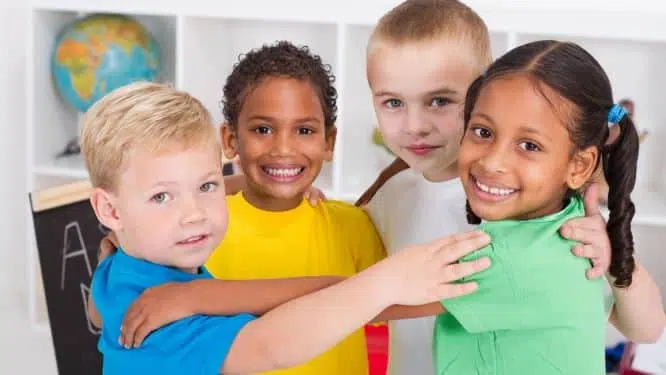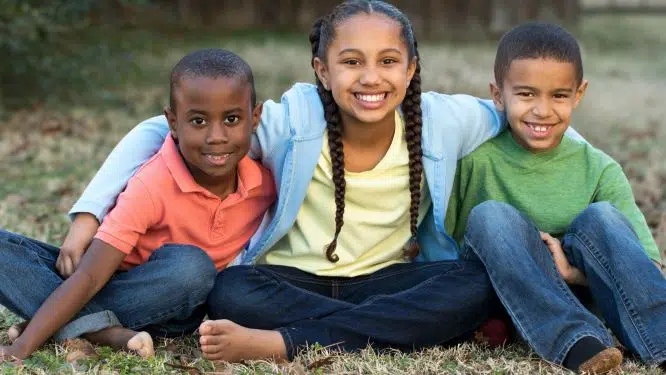Learning about emotions or emotional literacy is incredibly important.
Also, it takes a lot of time for most children. Structured games can really help this process, as well as talking about feelings a lot as the children are playing.
The best 14 emotion games for preschoolers are:
- Power of a hug
- Hugging games
- Emotion jars
- Don’t laugh or smile
- Weather feelings
- Expressions in a mirror
- Pairs emotions
- Emotions – hide your mouth
- Do what I say, not what I do
- Emotions collage
- Emotion art
- Feelings pebbles
- Walk around the circle emotions
- Color mix emotions
Children need to recognize emotions in others, and have them talked about. They also need to play around with pulling different faces, and seeing others do the same.
The activities are all fun and achievable. They are great for preschool children and young kids, but could also be tried out by older kids as well.
Right, let’s dive into the games themselves…

1. Power Of A Hug
There is probably no greater emotional balancer than being given a hug.
This game is a beautiful and very simple game. Have children move around a space. Call out a number. Whatever the number is, that is the number of people that are going to hug each other in groups.
If you call out, ‘1’ then the children hug themselves. Give yourself a squeeze with your eyes closed.
Call out ‘2’, then hug the nearest person to you.
Call out, ‘3’, then get involved in a team hug of 3, and so on. Children can also hug in groups of 4 or 5.
This is a great team-bonder and icebreaker.
2. Hugging Games
There are all sorts of well-known games that can be adapted to include hugging.
Some examples are:
Hug Relay
Do a normal type of relay race, but instead of handing over an object or tagging your team-mates, give them a hug at the change-overs
Musical Hug
This is a bit like musical statues. Dance around, but when the music stops, hug the person next to you.
Pass The Hug
Sit in a circle. The first person hugs the child next to them. They hug the person next to them, and the hug is passed like this around the circle.

3. Emotion Jars
This is a fun craft activity that can also be used to illustrate how our minds work.
If all the children are making one, you need one plastic jar each, water, glitter, beads, shells, and whatever else you would like to fill the containers with.
Pour water into the jar, add whatever ‘ingredients’ you like, and then screw the lid on.
Sit in a circle with the jars, when everyone has one.
Explain that these jars are like our minds. When we have too much going on, our minds go a bit like this…shake your jar!
Everyone shakes their jar and watches the snowstorm effect.
Explain that if we stop for a few moments and are calm, then our minds can start to be still again.
All leave the jars on the floor without touching them, watching the objects settle.
4. Don’t Laugh Or Smile
This is a fun game to warm up with.
The children sit in pairs. One child is going to be trying to make the other one laugh or smile.
They are going to use all their best tricks – silly faces, funny jokes, noises, impressions, and all the rest of it. The other one has to resist smiling or laughing.
This game helps children to think about how they can control their reactions and facial expressions.
You can extend the game with some mindful questions. Ask things like, ‘How did you feel when you smiled or laughed?’
5. Weather Feelings
It is positive to learn to compare your own feelings to the weather
Just like the weather, feelings cannot be fully predicted.
Also, feelings and weather are continually changing. Moods come and go like clouds. Bad weather passes, as do negative feelings.
Get the children to close their eyes. They are going to think of something that makes them happy.
They are going to breathe in, and then breathe out sunshine into the room. They are going to fill the room with light, and the sky will turn blue.
You can also try the same for other emotions, such as sad or angry, but always finish with happy.
For example, think of something that makes you sad. Fill the room with dark clouds.
For anger, think of creating a storm, with thunder and lightning.
But then, change to thinking of something that makes you happy, and once again fill the room with sunlight.
There are many similar games like this that are great for learning how to control breathing. Check out my favorite 15 breathing games for kids here.

6. Expressions In A Mirror
This is a classic emotions game that has withstood the test of time.
Give each child a small safety mirror, and then explore different facial expressions in the mirrors.
For example, try the following faces to express emotions:
- Make a long face
- A tiny face
- Puff your cheeks out
- Suck your cheeks in
- Eyes almost shut
- Eyes wide
- Mouth open wide
- Mouth pursed tight
Talk about how your faces feel as you try these out.
Then move on to emotion faces. Try some of the following:
- Happy, sad, angry
- Scared, surprised, disappointed, worried (all of these are depending on the age of the children. Start with the easy ones first)
Ask the children about how pulling the faces makes them feel. Do the faces remind them of any experiences – places, feelings, or people?
7. Pairs Emotions
The children sit in pairs for this one.
They sit facing each other. One child is going to be the ‘leader’ to start with, and the other is going to copy them.
The leader makes different faces, and the other child tries to copy them like a mirror. They can try different emotions. It’s good if the child copying can try to name how they are feeling as well.
They could also try silly faces, or unusual faces, animal faces, or anything else that they can think of.
This activity is a great building block for developing empathy.
This is one of 16 brilliant partner’s games that you can check out here.
8. Emotions – Hide Your Mouth
This is a fun variation on the pairs emotions game.
One child is the leader to start with, and the other child is going to be doing the guessing.
The leader makes some kind of emotion face (e.g. happy, sad, angry), but covers their mouth as they do so that it is hidden from the other person. That other child tries to guess which emotion their friend is doing.
Children will start to see that there are other clues around the face that can help them understand how another person is feeling, helping them develop empathy.
For example, there will be movements in the cheeks, around the eyes, and sometimes the forehead depending on the emotion.
9. Do What I Say, Not What I Do
This is a trickier pairs emotions game, which is for children from about five years old and upwards.
One child is the leader, and the other child has to try to do what they say.
The leader will try to do one emotion, but say another one for their partner to copy. As an example, they might say, ‘Do a happy face,’ but then do an angry one. Their partner has to do what they say, not what they do (e.g. do a happy face).
This is a fun game of trying to trick your partner, whilst also thinking about emotions.
To check out many more exciting listening games such as this, then take a look at my favorite 17 active listening games.
10. Face Collages
This takes a little preparation to set up.
Find lots of faces of people in magazines (or photocopied from books), and cut them out. Ideally, they will be faces of people showing a range of different emotions.
Cut the heads in half horizontally about level with the base of the nostrils.
The game for the children is to make different faces. Use different upper and lower halves of the heads, and talk about what they look like.
It’s a fun game of experimentation, and making funny-looking characters all showing different emotions.
11. Emotion Art
This is extremely open-ended and can be achieved in a range of ways.
The idea is to use different media to portray an emotion.
Emotional music of some sort is great for this. It could be classical, or some other form of music that strongly suggests a particular way of feeling.
Put this music on, and explore whatever media it is – painting, drawing, collage, creating marks in messy substances, or whatever else.
12. Feeling Pebbles
This is a very simple resource to set up.
You basically need a few pebbles of some sort, and you draw some simple emotions on the pebbles. For example, you could draw a simple happy, sad or angry face. You could also draw things that might remind people of these emotions, for example, the sun representing happiness, or a storm cloud for anger.
The easiest way is to draw these with permanent marker onto the pebbles, but you could also paint them on using acrylic paint for a more magical effect.
Have the stones in a basket. There are different games you could do, such as:
- Pass around the basket, take out a stone and try to say what emotion it is
- Take out a stone, and think about a time when you felt like that
The children could attempt to make some of their own stones, by drawing onto pebbles.

13. Walk Around The Circle Emotions
This is a fantastic game that includes a bit of role-play and drama. It is also excellent for eye contact.
The children sit in a circle. Have three emotion pictures that you have simply drawn on pieces of paper. The easiest ones are ‘happy’, ‘sad’ and ‘angry’. Place the pieces of paper in the middle of the circle, so that the children can see them.
Now, one child is going to go first. They are going to secretly pick one of these emotions, and then walk around the circle demonstrating the feeling. For example, if they are pretending to be happy, they might skip around, with a delighted face. If they imagine they are angry, they might stomp around, with hunched shoulders and scowling faces.
The other children are going to point to one of the emotion faces, showing which they think the child has chosen.
Talk a little about body language, and facial expressions.
Then another child has a go.
14. Color Mix Emotions
Painting can provide a fantastic medium for expressing emotions.
Having a range of colors can provide children with the opportunity to explore, and try to represent their emotions through art.
It may not look too pretty! But this activity will be all about the process.
Final Thoughts
Learning about emotions is a key skill in life. The more emotional literacy opportunities that children can have in their early years of life, the more firmly the concepts of understanding emotions can be implanted in their minds.
Research suggests a clear link between an emotionally literate environment, and creating emotionally literate children. (Source)
Take some time to try out some of these emotion games today!
If you’ve enjoyed this article, then another one that you will really like is 28 Relaxation Techniques For Kids.
